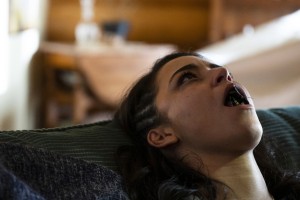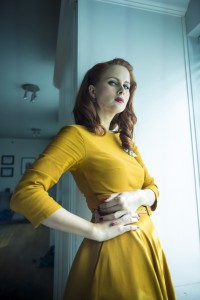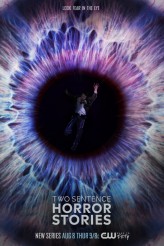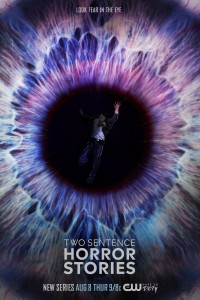
Nicole Muñoz as Sofia in TWO SENTENCE HORROR STORIES – Season 2 – “Fix” |©2021 The CW Network/Kailey Schwerman/Stage 13
TWO SENTENCE HORROR STORIES began as an online challenge. Creator Vera Miao made a digital anthology series from the concept in 2017. It was developed for television by Stage 13. The first made-for-television season premiered in the U.S. on The CW in 2019.
Now, the second season of TWO SENTENCE HORROR STORIES is airing on The CW on Tuesday nights, with two separate segments airing together within an hour timeslot. Meanwhile, the writers’ room is working on Season 3.
Creator Miao is still the show runner, but much of the Season 2 production team is new to TWO SENTENCE HORROR STORIES. This includes executive producer Liz Levine, who shares Miao’s desire to combine horror with social justice subject matter.
This is evident in the TWO SENTENCE HORROR STORIES Season 2 premiere episodes, which aired on January 12. “Bag Man” finds high school students trapped with a monster due to the poorly-thought-out lockdown policies, and “Elliot” sees a transmasculine high schooler, played by James Goldman, trying to find a way to thwart bullies without harming them.
Speaking by phone, Levine talks about why TWO SENTENCE HORROR STORIES merits a much longer conversation.
ASSIGNMENT X: How did you become involved with TWO SENTENCE HORROR STORIES?
LIZ LEVINE: I was tangentially aware of the show, because I had a relationship for four or five years with Stage 13, particularly Stacia Warren there. At the point that they finished their first broadcast season, they had shot it live on the ground in New York, with two teams running consecutively, and it has been “a strenuous experience,” is the language I will choose. And so, they were wrapping their minds around what might be a more effective way to shoot a show that had the temporal and budgetary parameters that TWO SENTENCE has.
When they reached out to me, I said, “I have some ideas.” That included moving the series onto a soundstage, getting rid of the time that you spend hopping from location to location, and locking a team in at home and doing some builds, but also running two teams, two first ADs, two cinematographers, and so always having a team in prep, and then a team in production. Ways to create a little bit of breathing room in the making of this that didn’t make it feel that everything was happening at once on top of each other. And I think, from there, they just got excited about the way that I could see structuring it, and executing it, in a really practical way.
So, we got into all of those practical producer things, and I think, the deeper we got, the more there was also the realization that I was a creative storyteller in my own right. I’ve told stories in a lot of other mediums, particularly print, and that maybe there was a voice here that could really capture Vera’s DNA, and the essence of this show, and help drive it forward, which I think we have done in a relatively successful way for this season.

Leanne Lapp as Holly in TWO SENTENCE HORROR STORIES – Season 2 – “Instinct” |© 2021 The CW Network/Kailey Schwerman/Stage 13
AX: When you say “temporal and budgetary constraints,” what are those for this show?
LEVINE: Very simply, it is a small show. It is also an anthology series, which means that every week, we have an entirely new cast, and an entirely new set of locations. We are not financed the way other anthology series, like BLACK MIRROR, might be. And yet, to do those turnovers is theoretically a very expensive thing to do. So, this was just about building a machine that could wrap their hearts and minds and arms around what it meant to shoot an anthology series at the same pace, and maybe with lesser budget, than you would shoot a traditional series. Normally, an anthology series would be a slower pace, with a bigger budget. This one is a faster pace, with a lesser budget [laughs]. But it’s also part of the magic of the show, to be frank.
AX: At least in the first two segments of this season, it seems aimed at a YA audience. Is that the intent?
LEVINE: No. The CW has been super-supportive of the types of stories that we want to tell, the idea that we’re coming from a place of social justice. It just happens that both “Elliot” and “Bag Man” feature minors as our heroes and protagonists, so they have a tendency to feel closer to a YA audience. But the truth is that the run of the series does cover a much broader range, and these two happen to be our most youthful episodes, as it were.
AX: Were you able to reuse sets, since both of them take place in a school?
LEVINE: Yes. The basement corridor that you see in “Elliot,” where he meets the janitor [played by Janet Kidder], has become the very cleaned-up high school corridor that you see in “Bag Man.” And then the “Bag Man” classroom, where all of our BREAKFAST CLUB-esque characters spend the run of the show, also became parts of living rooms, apartments, a morgue for the episode “El Muerto.” We had about a twenty-five-thousand-foot soundstage that we used for at least fifty percent of the locations. So, there are some live locations in the series, and some on the studio floor. Everything in the basement with the janitor was built on our studio floor, and then everything really in the high school is in a high school.
AX: The press release for “Elliot” said the episode had an LGBTQ writer, director, and lead. Did they all come as a package?
LEVINE: They all came separately. Stephanie Adams-Santos, the writer, has been long a part of the writing room. Once we got a copy of the script, we interviewed a whole number of directors. The show was developed to create opportunities both in front of and behind the camera for people whose voices have not already been heard. We felt it was really important that we have a transmasculine director. and we found Chase Joynt, who was just coming off a big win on his documentary, NO ORDINARY MAN, which did phenomenally at TIFF, and is currently eating up the festival circuit.
Then Chase and I put our heads together around casting, and we were deeply supported by GLAAD [originally the Gay & Lesbian Alliance Against Defamation, still using the acronym although the official name has changed to include trans and bisexual individuals], the organization, and we went on a real hunt for Elliot. Our casting director out of Toronto, Stephanie Gorin, who is probably most famous for casting the IT movies and the SAW franchise, put out a very wide net, and came back with audition tapes of a small handful of kids, James Goldman among them. We sent those tapes to GLAAD, and we got on the phone, and had conversations, As you can see from the episode, James just sparkles, is a deeply special human being, wise well beyond his years, and I think Chase and I really knew when we saw him that this was the kid that was going to be able to play this role. He just took it on, and he knocked it out of the park.
AX: What was GLAAD’s input in seeing the tapes?
LEVINE: We did look at one other young actor closely, who was not yet identifying in terms of their gender or sexual orientation. They were also a very talented young person, and I think that the way GLAAD really supported us was in unraveling some of the language, in educating us, and helping us peel back layers, and look very closely. We are all being educated on this language [appropriate and respectful regarding people in gender transition], myself as a queer woman as well. This is why we turned to GLAAD, because we all need to be educated on this, and we all need to be learning, and it was really a fantastic experience for me. Having support like that is huge. The show is uniquely concerned with authenticity, and having real integrity behind what we do.
I think that James was the strongest, in terms of performance and his audition. But also, James can really speak to a young trans community that are going to turn to him as a role model, and a leader, and I think that the other young actor, who has not yet chosen how they’re going to identify, maybe has a less clear voice.
Vera and I are very sure of the role of this show, and what it speaks to, and social justice issues. And the response from the audience, and the fact that we need to be very prepared to stand behind these episodes, validate them, believe in them, and James is somebody who is not only great onscreen, but also really felt like that young role model, who other kids could turn to in the moments of feeling lost and alone.
AX: Besides GLAAD, have you consulted other organizations regarding specific issues?
LEVINE: Our final episode, “Manifest Destiny,” is an indigenous story, and I reached out to Cree elders, and indigenous tribal elders, who can help us with that kind of authenticity. [There has been] reach-out for authenticity from experts on every single one of these episodes, and every single one of these protagonists, who are all people that we maybe haven’t heard from, standing in their truth, the way that we should be hearing from them. It’s our greatest hope that this show does that right.
AX: Can you say what some of the other issues are that you deal with this season?
LEVINE: Sure. “Ibeji” is a story about Nigerian twins that was motivated by a conversation about the way African-American women are handled inside the medical system. It came from a conversation about Serena Williams and the medical experience that she had had, where she said to the doctors many times over, “There’s something wrong here.” Women, and women of color even more specifically, have often been put by the medical community into a box that is, “Well, you’re complaining, or you’re crazy, or you’re hysterical. You are not a doctor, what would you know?” So “Ibeji” really addresses the problems with the healthcare system, and the way that different faces and voices are taken at different levels of seriousness in there.
We have an addiction story about loss and addiction. The addiction is both the demon and the real-life horror in that episode. We have an episode called “Counterpart,” apart a young Filipino protagonist, who is working very hard to fit in with his very Caucasian workmates, and what it means to sort of erase one’s own identity in the hopes of belonging. That was an important one this year.
It is really all about protagonists who haven’t told their own stories. For me, one of the most fascinating things was watching a kid like James get to play something of himself that is true. In “Counterpart,” we cast an older Filipino woman out of Montreal, who on her last day was in tears about what it meant to play a role where she spoke her own language, and interacted with her own cultural traditions. Even in the set of the home that we had built for her, that our production designers were so culturally specific, so detailed, that this felt like home for this sixty-year-old female actor, to step into this role, and speak her native language, and live in a home that reminded her of her parents’ home.
AX: When you’re crafting premises, do you start with, “This is an issue we’d like to discuss, how do we make this scary?” Or do you start with, “Well, this is scary, what would be an issue that pairs with it?”
LEVINE: This is a more writing room-heavy question. I’m a creative EP who consults with the writers’ room, but I myself am not writing any of the episodes. But it did come up in an earlier interview today, and both Vera and Stephanie, who wrote “Elliot,” articulated this as a very organic process. I think everybody involved in this show is politicized, connected to the social justice issues in the world around them, the writing room is curated to reflect different cultural, gendered, sexual orientation backgrounds. So, it’s a very diverse room, and I think people really come to this with their own set of passions, talking about the things that matter, the things that make us angry, and where those things can transition into horror. But it is not a ripped-from-the-headlines show.
Where it starts is actually with the concept, and the idea is that there is always a horror trope we are leaning into. So, for “Elliot,” that is a troll under the bridge, a PAN’S LABYRINTH kind of dark fairytale horror trope, and then there is always a real-life horror. For “Elliot,” that’s obviously the struggle for this young boy trying to come into his own, and handle the slew of micro-aggressions and predators that are directed at him. And we sort of go from that part of life, “What is the trope we are leaning into here?” and then, “Who is the protagonist we are centering, and what is their real real-life horror?” And then we work our way to an entire script.
AX: One potential additional wrinkle to combining social justice and horror is that when you’ve got somebody fighting for their rights in any way, you don’t want to say, “This is a futile quest,” or that it’s something that they shouldn’t do. But of course, horror is generally about bad consequences for doing practically anything, including sometimes just waking up in the morning. So, how do you balance making it horror, without punishing people for being their authentic selves?
LEVINE: This was definitely a minefield. It’s something that we pause and reflect on all the way through. I think in terms of “Elliot” specifically, Chase and Vera and I had a number of conversations, part of which started with Chase really wanting a predator point of view on the top and bottom of this show, because there is always trans violence, and the sense of being watched for that community, that is consistent even today. And yet, there was definitely the moment when Chase sat down in my office, and we looked at the little face of James pinned to my wall, and said to each other, “But we also have to make the argument, it gets better.” How do we make both of these arguments in picture?
Chase resolved this with a very refined set of ideas that involved opening and closing the show with a camera lens that is clearly a predator’s point of view, but also, “Elliot” ends with Elliot having lived a full life as an older man in a comfy chair in front of a fire, closing his fairytale book on his story. And so, both messages can stand. It does get better, you will survive this, and until the world really changes, to lead with love, there are predators out there, and you are being watched. And so, it was really an effort to make all things true in those moments.
AX: In terms of production, are you utilizing any of the same resources from Season 1, or is everything new?
LEVINE: Season 2 was a full reinvention of the wheel. The only pieces that were really brought forward were Vera, because of course, the show is truly her DNA, and Guy Pooles, who was the original d.p., since the digital series. He came with us to Canada, and we partnered him with a d.p. that I have been with for a dozen years, Naim Sutherland. Guy helped Naim and I create a tone bible, which talked about how the camera moves in this show, and what the camera’s role is in TWO SENTENCE HORROR STORIES, and what the color tone and palette of the show should be. So, those creative elements were really brought to the fore by Guy and Vera, but production-wise, and in every other sense of the word, Season 2 was a fresh start for the show. You will see that when you watch them side by side. Season 3 will look much more like Season 2 than Season 2 looks like Season 1.
AX: So, you’re going for an anthology that has a tonal consistency, even though all of the people are different from episode to episode?
LEVINE: Yeah, it’s the idea of a number of planets that live in the same universe, so that the hope is that you can turn on the show ten minutes in and have an instantaneous response to understanding that you’re watching TWO SENTENCE HORROR STORIES. So, it has a lot of green, a lot of muted colors. Sharp, bright colors, things like red, are only used very specifically as motivated by characters, or making certain points in the script.
And the camera doesn’t necessarily move a lot for the viewer. So, an actor may walk around a corner, and the camera maybe has a post or a doorframe in the way, and we don’t work our way around that. Sometimes, it’s the thing that we don’t see, or the thing that we only see half of, that can be the most scary for us. The world seems very grounded and real that way, as opposed to making the horror supernatural or otherworldly. That’s important to us, because these characters are real, and the true-life horror that they are experiencing is also very real. So, we haven’t leapt into the fantasy that makes it easy for the audience to see every nook and cranny of what’s going on.
AX: Is there anything else you’d like to say about TWO SENTENCE HORROR STORIES right now?
LEVINE: Just that I’m really excited that it is beginning to find a place in the market, and a broader audience. I think everyone who loves horror should be watching this show. I think everyone who feels strongly about social justice and the state of the world should be watching this show. I think it’s rebirthing horror into what it was always meant to be, which is a genre that allows us to talk about the things that are hard to talk about in any other way. I think it is important and timely. And I also think it’s a super-fun, scary, wild ride, the best of all the things.
Follow us on Twitter at ASSIGNMENT X
Like us on Facebook at ASSIGNMENT X
Article Source: Assignment X
Article: Exclusive Interview with TWO SENTENCE HORROR STORIES Executive producer Liz Levine on Season 2
Related Posts:












